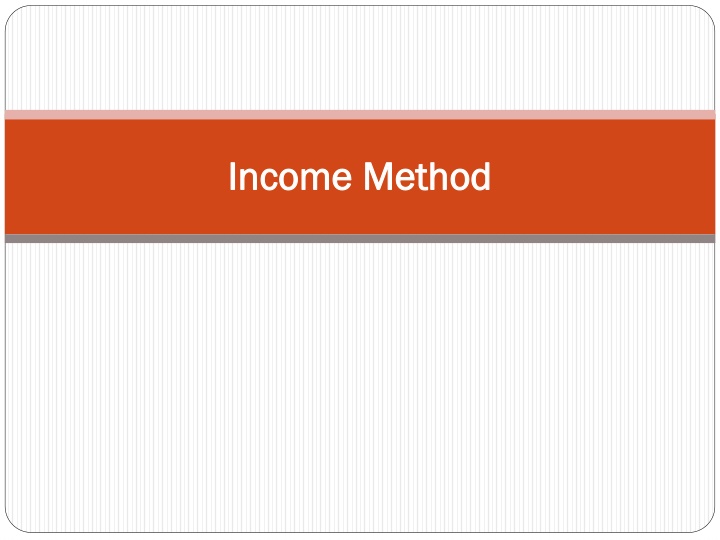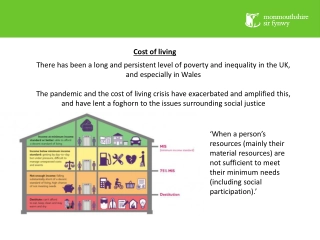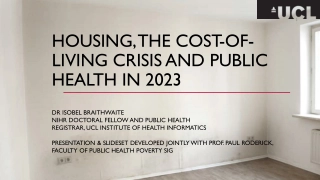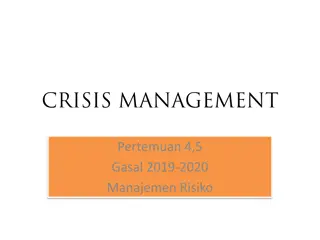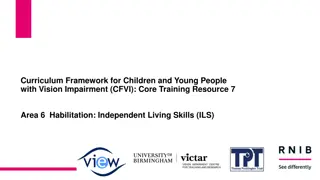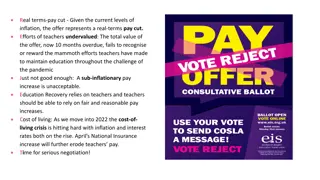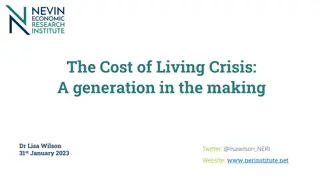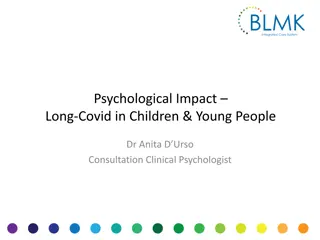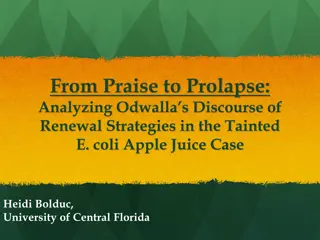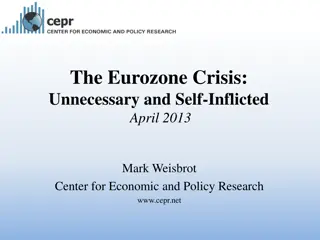Impact of the Cost-of-Living Crisis on Children & Young People
This crisis sheds light on the deepening challenges faced by children and young individuals due to the rising cost of living in the UK. Explore key concerns, recommendations, and initiatives in response to the growing child poverty issue.
Download Presentation

Please find below an Image/Link to download the presentation.
The content on the website is provided AS IS for your information and personal use only. It may not be sold, licensed, or shared on other websites without obtaining consent from the author.If you encounter any issues during the download, it is possible that the publisher has removed the file from their server.
You are allowed to download the files provided on this website for personal or commercial use, subject to the condition that they are used lawfully. All files are the property of their respective owners.
The content on the website is provided AS IS for your information and personal use only. It may not be sold, licensed, or shared on other websites without obtaining consent from the author.
E N D
Presentation Transcript
Income Income Method Method
The income method calculates the National Income based on factor incomes. The incomes received by every resident of a country for the productive services provided by them during a year are added together to determine the National Income of an economy.In other words, under the Income Method of calculating National Income, all incomes of a country accruing to the factors of production through rent, wages, profits, interest, etc., are added up together for the determination of National Income. This method is also widely Payment Method or Distributive Share Method. The total of all the income earned by factors of production within a domestic territory of a nation is known as Domestic Income(NDPFC). known as the Factor
Components of Factor Components of Factor Income 1.Compensation of Employees (COE) COE refers to the amount paid to employees directly or indirectly by the employer in exchange for their services.It includes all kinds of payments and benefits received by the employee,directly or indirectly. COE consists of three elements: Wages and Salaries in Cash:It consists of all monetary benefits like salaries,wages,bonuses, commissions, dearness allowance,etc. Wages and Salaries in Kind: It includes all non-monetary benefits like health & education facilities, rent-free accommodation, free car, etc. An imputed value of such benefits should be calculated in National Income. Employer s Contribution to Social Security Schemes: It consists of the employer s contribution to the employee s security. For example contribution in gratuity, provident fund, labor welfare fund, etc.The main aim of these contributions is to ensure employee security. Income
2.Rent and Royalty Rent is that part of the factor income that arises from ownership of a land and building. Rental income includes both actual rent obtained from let-out land and imputed rent obtained from self-occupied land.The Imputed rent of a self-occupied house is calculated at the market value of that house. Royalty refers to the income earned from granting leasing rights for self-owned assets. For example, the mineral deposits (coal, natural gas, iron ore, etc.) owners can earn more through royalty, by giving mining rights to the contractors.
3.Interest Interest refers to the income earned from lending funds to production units. It includes both actual & imputed interest provided by entrepreneurs. Interest income consists of the interest on loans taken for productive services. It doesn t include interest paid by one firm to another, interest paid for loans by a consumer taken for consumption,and interest paid by the government on public debt.
4.Profit Profit is the income or reward of the entrepreneur for his contribution to manufacturing of goods & services. In other words, it is the residual income that an entrepreneur earns after paying off all other factors of production. The profit earned is used for three purposes: Corporate Tax: It is the tax paid by a firm to the government for the profits earned by them in a particular period. It is also known as business tax or profit tax. Dividend: Dividend is the part of profit given to shareholders in their shareholding ratio.It is also known as distributed profits. Retained Earnings: It is that part of the profit that is kept aside as a reserve to handle the uncertain situations that may arise in a business. It is also known as reserves and surplus or undistributed profits or savings of private sector. Profit = Corporate Tax + Dividend + Retained Earnings
Operating surplus is another term used in factor payments. It is the sum total of income from property, i.e., rent, royalty, and interest, and income from entrepreneurship,i.e.,profit. Operating Surplus = Rent + Royalty + Interest + Profit or = Value of Output Intermediate Consumption Compensation of Employees Mixed Income Consumption of Fixed Capital Net Indirect Taxes Operating surplus arises in both government & private enterprises.However,it does not arise in general government sector,as they operate for the benefit of general public. Therefore, factor income is nil in general government sector.
5.Mixed Income It is the income generated by unincorporated enterprises, such as small shopkeepers, retail traders, etc., and own-account workers like farmers,barbers,etc.The term mixed income is used for any kind of income which has more than one kind of factor income. It arises from self-employed workers productive services. The income of these workers includes profit, rent, wages, and interests and can not be separated from each other. For example, a tutor giving tuitions at his residence.
Precautions of Income Precautions of Income Method 1. Transfer Income will not be included: Transfer incomes such as donations, charity, scholarships, old age pensions, etc., are not counted in the National Income, as these activities are not connected to any production activity and no value addition takes place. 2. Income from Sale of Second Hand Goods will not be included: Income received from the sale of second hand goods also known as capital gains is not calculated in National Income, as their original sale has already been included at the time of purchase. If these goods are calculated again, then it will lead to the problem of double counting. However, any kind of commission or brokerage received by agents on the sale of these goods will be included, as it is an income received for rendering productive services. Method
3. Income from Sale of Securities will not be included: Income from the sale of bonds, shares, and debentures will not be calculated, as these transactions do not contribute to the current flow of goods & services.These financial assets are just paper claims and include the transfer of title only. However, any kind of commission or brokerage on such assets is included in National Income, as it is a productive service. 4.Windfall Gains will not be included:Income that arises from windfall gains like horse racing, lotteries, etc., are not calculated in the determination of National Income, as they are not connected with any kind of production activity.
5. Imputed Value of Services by Owners of Production Units will be included: The imputed value of self- occupied houses, production for self-consumption, interest on own capital, etc., are included under National Income, as these are productive activities and add to the current flow of goods & services of the economy. 6. Payment out of Past included: Payment out of past savings such as interest tax, gift tax, death duties, etc., is not calculated in National Income, as they are paid out of past savings or wealth and do not contribute to the current flow of goods & services of the economy. Savings will not be
